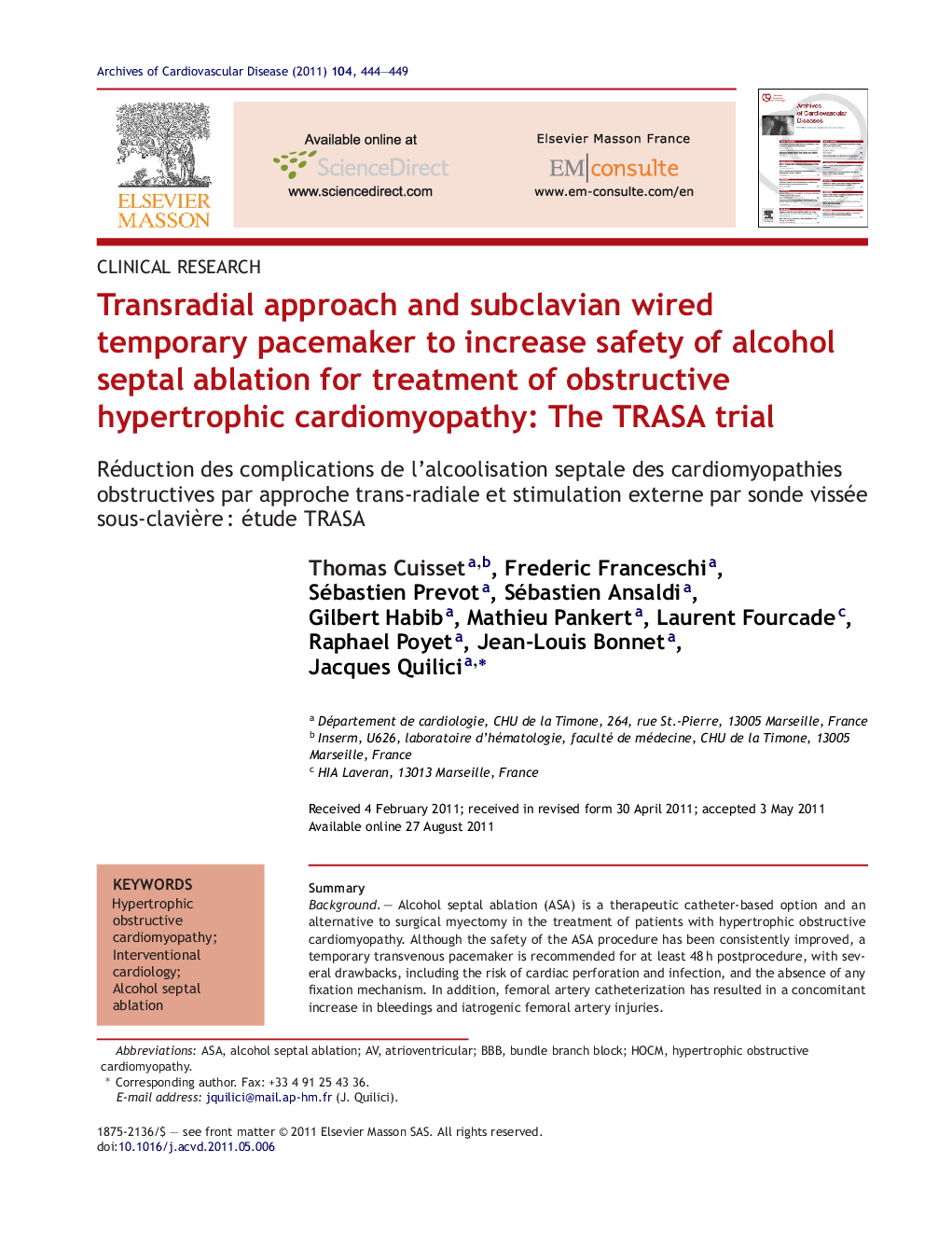| کد مقاله | کد نشریه | سال انتشار | مقاله انگلیسی | نسخه تمام متن |
|---|---|---|---|---|
| 2888843 | 1574382 | 2011 | 6 صفحه PDF | دانلود رایگان |

SummaryBackgroundAlcohol septal ablation (ASA) is a therapeutic catheter-based option and an alternative to surgical myectomy in the treatment of patients with hypertrophic obstructive cardiomyopathy. Although the safety of the ASA procedure has been consistently improved, a temporary transvenous pacemaker is recommended for at least 48 h postprocedure, with several drawbacks, including the risk of cardiac perforation and infection, and the absence of any fixation mechanism. In addition, femoral artery catheterization has resulted in a concomitant increase in bleedings and iatrogenic femoral artery injuries.AimsTo evaluate and validate the feasibility of less invasive management of ASA using the transradial approach and a subclavian wired temporary pacemaker.MethodsTo avoid transfemoral temporary pacing, we used a subclavian bipolar active-fixation permanent pacing lead, stitched to the skin and connected to a desterilized recuperation pacemaker. The day before discharge, if there was no high-degree atrioventricular block, the pacemaker lead was removed. In all patients, we used the right radial access and the left main was cannulated with a 6F Judkins left 3.5 guiding catheter.ResultsThirty consecutive patients were prospectively and successfully included in our study. No complication was observed during the hospital stay, neither access-site nor stimulation-lead related.ConclusionsOur study shows the feasibility and safety of a transradial approach and a subclavian wired temporary pacemaker. The reduction in periprocedural complications offered by this strategy reflects the less invasive nature of ASA, without increasing the cost and complexity of the procedure.
RésuméContexteL’alcoolisation septale est une alternative à la chirurgie dans la prise en charge des cardiomyopathies hypertrophiques obstructives. Malgré l’amélioration de la sécurité de cette technique percutanée, le risque de trouble conductif nécessite une stimulation externe pour au moins 48 heures après la procédure. La technique habituelle de stimulation temporaire transfémorale expose à un risque de tamponnade, de déplacement de sonde ou d’infection. De plus, la voie d’abord artérielle fémorale qui est utilisée dans toutes les études majore le risque hémorragique de la procédure.ObjectifsNotre objectif est d’évaluer la faisabilité et l’intérêt d’un abord artériel radial associé à une stimulation temporaire par sonde vissée sous-clavière pour réduire le risque de complication périprocédurale.MéthodesNous avons utilisé des sondes de stimulation bipolaires vissées introduites par voie sous-clavière, la partie proximale de la sonde restant externe et connectée à un boîtier de pacemaker de récupération programmé en VVI. La veille de la sortie, en l’absence de trouble conductif, le dispositif était retiré. La voie artérielle radiale a été également proposée à tous les malades, avec utilisation de cathéter guide JL 3.5 6F.RésultatsTrente patients consécutifs ont pu bénéficier avec succès de cette approche. Nous n’avons observé durant la phase hospitalière aucune complication liée à la stimulation temporaire ou à la voie d’accès artérielle.ConclusionsNotre étude montre la faisabilité et l’intérêt en terme de sécurité de l’abord radial et de la stimulation temporaire sous-clavière par sonde vissée. La réduction des complications et l’amélioration du confort du patient s’inscrivent dans la logique du développement de l’alcoolisation septale, sans majoration du coût ou de la complexité de la procédure.
Journal: Archives of Cardiovascular Diseases - Volume 104, Issues 8–9, August–September 2011, Pages 444–449